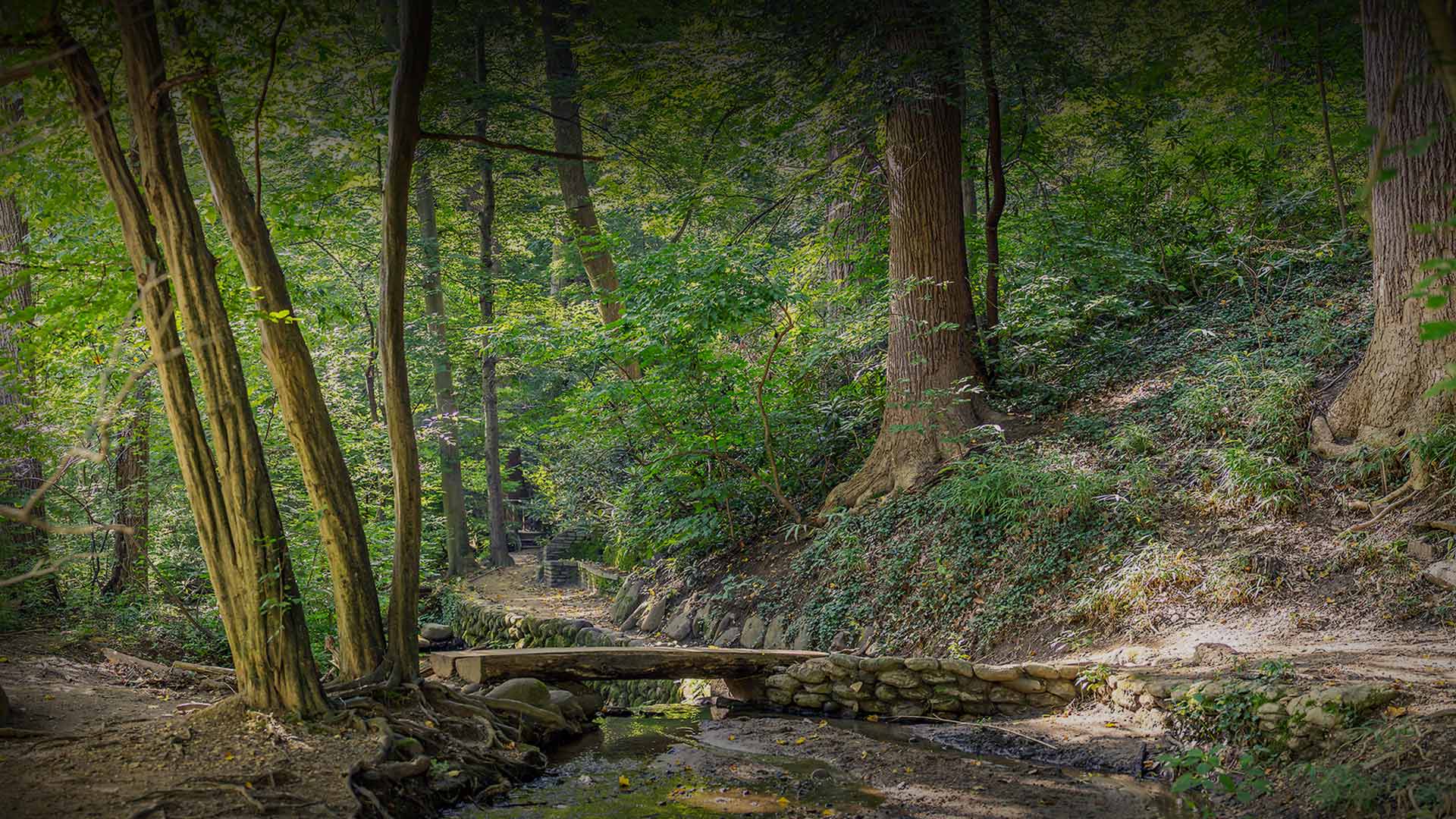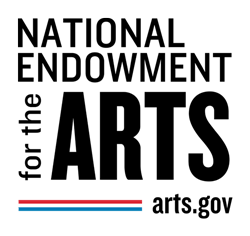A 27-acre pastoral oasis in the middle of Georgetown, Dumbarton Oaks Park is the woodland and meadow portion of Mildred and Robert Bliss’ original 53-acre Dumbarton Oaks estate. This quintessential wild garden of the Country Place Era is the masterwork of Beatrix Jones Farrand, America’s first woman “landscape gardener,” as she called herself, and is her only remaining wild landscape. 2021 marks the centenary year of the park, making it especially significant that the landscape remains true to Farrand’s original design intent. Additional funds and volunteer work will be necessary to protect the park as it enters its second century.
History
The design of Dumbarton Oaks Park in Washington, D.C., is the result of a decades-long partnership between landscape gardener Beatrix Farrand and her client, Mildred Bliss. After decades of neglect, the woodland garden is now being revitalized to reveal the 100-year old Farrand design, and is being rediscovered by a wide array of visitors.
Farrand, the only woman founding member of the American Society of Landscape Architects (ASLA) in 1899, was raised in an upper-class, literary New York family; Edith Wharton was her aunt. She grew up taking summer vacations to Reef Point, Maine, where she developed an admiration for garden design. Her training in landscape architecture and ecology was self-designed, and included a European tour and an informal apprenticeship with Charles Sprague Sargent of the Arnold Arboretum at Harvard, one of the most preeminent practitioners in the field. She married historian and library director Max Farrand in 1913. Over the course of her 50-year career as a landscape gardener, the title she prefered, Farrand completed more than 200 designs, including university plans (Yale, Princeton, Occidental) and a garden at Woodrow Wilson’s White House. She was known for her restraint in planting, her maintenance plans, and her use of and advocacy for native plants, all of which can be seen at Dumbarton Oaks Park.
Mildred Bliss, a prominent member of Washington, D.C., society, and her husband Robert Bliss, a diplomat, purchased a house in Georgetown in 1921, and hired Farrand to design both a formal flower garden and a Naturalistic adjoining park. Farrand’s work for the couple lasted two decades, during which time she and Mildred, who called one another “gardening twins,” worked together closely, though often only through written correspondence as Robert’s work took the couple out of the country, and Farrand was first based in Reef Point, Maine, and, after 1928, in Montecito, California. Over the years, the collaboration revealed thousands of drawings passed back and forth with notes. Bliss was a loyal friend as well as a client, and secured commissions for Farrand, who had trouble developing her practice after her move out West.
The Bliss estate work was inspired by the classical Roman tradition of creating living spaces out-of-doors. For the upper formal gardens (now known as Dumbarton Oaks and administered by Harvard University), Farrand designed garden rooms for entertaining, as well as recreation areas that included a swimming pool and tennis courts. The property had complex topography and significant grade changes, demanding concerted focus on engineering by Farrand.
 Wooden bridge and rustic gazebo at Dumbarton Oaks Park, Washington, D.C.; photo courtesy National Park Service, 1963.
Wooden bridge and rustic gazebo at Dumbarton Oaks Park, Washington, D.C.; photo courtesy National Park Service, 1963.
The adjoining park was developed from 27 acres of the Bliss property. Here, Farrand was likely inspired by the work of the British writer William Robinson’s Victorian-era wild gardens. She transformed a landscape of abandoned farm buildings and dumping grounds left behind by the previous owners to create “the illusion of country life within the city” with an array of constructed waterfalls, wildflower gardens, paths, ponds, woodlands, meadows, a stone bridge, and other architectural elements. She used marking stones to alert visitors and walkers to important elements in the landscape such as paths and vistas. A stone stairway topped by an arched gate led the way from the wild gardens back to the more formal estate. Within the park, special elements included a hill carpeted with yellow forsythia, a beech grove, and curved paths winding around the hilly terrain planted with thousands of bulbs. She used native sedges and other grasses to create a ring of meadows with interspersed woodlands in carefully orchestrated conversation. Scenic vistas up to the house and across the park were important to Farrand, to create a sense of drama in the surroundings.
 Upper Three Sisters Falls at Dumbarton Oaks Park, Washington, D.C.; photo courtesy HABS, ca 1960’s.
Upper Three Sisters Falls at Dumbarton Oaks Park, Washington, D.C.; photo courtesy HABS, ca 1960’s.
In 1940 Robert and Mildred Bliss gifted Dumbarton Oaks Park to the National Park Service (NPS) and their Georgian mansion and ten-acre formal garden to Harvard University. Farrand continued to be connected to the property as she wrote up guidelines, known as the Plant Book, for maintenance of the formal garden at the request of the first park director, and served as an advisor to the NPS until her retirement in 1951. Since then, however, and despite Farrand’s best efforts to set the park on good footing, it has suffered from decades of neglect. Invasive vines choked the trees and plantings, and silt and stormwater almost finished the job.
Reports, including one from the Historic American Buildings Survey in 1988, a Cultural Landscape Report from the NPS in 2000, and a Historic American Landscapes Survey in 2008, helped bring attention to the park. In 2011 the Dumbarton Oaks Park Conservancy was formed to help restore Farrand’s vision for the property. The site has seen a dramatic transformation from its decline into a series of dark, impenetrable corridors to its recent rehabilitation into open landscape spaces with sweeping views and re-established connections to the house and formal garden. Dumbarton Oaks Park was listed in the National Register of Historic Places in 2004.

Threat
The threat to this cultural landscape includes the impact of stormwater runoff—severe storms ravage the in-stream structures, paths, and vegetation. The design work for the stormwater solution began in 2017 and is still in process. The Conservancy is actively working on several pipeline projects, to be “shovel ready” when funding is available: for example, the restoration of the Gray Arbor Memorial, a garden folly sited at the edge of the stream. A 2020 Master Plan to be completed by the Conservancy will provide comprehensive plans for future maintenance.
What You Can Do to Help
Donate to the Dumbarton Oaks Park Conservancy. The public is invited to donate to the Dumbarton Oaks Park Conservancy campaign that will be used to match the NPS Centennial Challenge Grant funds, and participate in the interpretative and educational programming that elevates the focus on saving this storied landscape.
Volunteer with the Conservancy. Though currently on hold during the pandemic, the Dumbarton Oaks Park Conservancy regularly offers volunteer opportunities such as clean-up days. The Conservancy also welcomes those who can perform plant surveys or other services to the ongoing work at the park.
Visit the Park. If you are local to the area, take a restorative walk in Farrand’s designed landscape.
Contact the local, regional and National Park Service leaders to stress the importance of this landscape and warn of the threats which are destroying it.
5200 Glover Rd, NW
Washington, DC 20015
Rock Creek Park administrative offices: 202-895-6000














